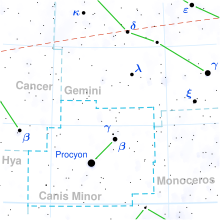
| |
| Observation data Epoch J2000.0 Equinox J2000.0 (ICRS) | |
|---|---|
| Constellation | Canis Minor |
| Right ascension | 07 28 09.79333 |
| Declination | +08° 55′ 31.9068″ |
| Apparent magnitude (V) | +4.33 (4.46 + 6.66) |
| Characteristics | |
| Spectral type | K3 III Fe-0.5 (K4 III + K1: III) |
| U−B color index | +1.53 |
| B−V color index | +1.43 |
| Astrometry | |
| Radial velocity (Rv) | 46.8±0.3 km/s |
| Proper motion (μ) | RA: −61.09 mas/yr Dec.: −10.70 mas/yr |
| Parallax (π) | 10.25 ± 0.47 mas |
| Distance | 320 ± 10 ly (98 ± 4 pc) |
| Absolute magnitude (MV) | −0.5±0.1 |
| Absolute magnitude (MV) | 1.7±0.2 |
| Orbit | |
| Period (P) | 389.310 ± 0.012d |
| Semi-major axis (a) | 17 mas |
| Eccentricity (e) | 0.25856 ± 0.00039 |
| Inclination (i) | 66° |
| Periastron epoch (T) | 2449849.172 ± 0.089 HJD |
| Argument of periastron (ω) (secondary) | 142.079 ± 0.090° |
| Semi-amplitude (K1) (primary) | 21.243 ± 0.010 km/s |
| Semi-amplitude (K2) (secondary) | 21.526 ± 0.017 km/s |
| Details | |
| γ CMi A | |
| Mass | 1.88 M☉ |
| Radius | 36.8±2.6 R☉ |
| Luminosity | 321±33 L☉ |
| Temperature | 4,036±100 K |
| Rotational velocity (v sin i) | 5±2 km/s |
| Age | 1.3 Gyr |
| γ CMi B | |
| Mass | 1.85 M☉ |
| Radius | 7.8±1.0 R☉ |
| Luminosity | 25.4±5.2 L☉ |
| Temperature | 4,658±200 K |
| Rotational velocity (v sin i) | 2.0±2.0 km/s |
| Other designations | |
| γ CMi, 4 CMi, BD+09°1660, GC 9974, HD 58972, HIP 36284, HR 2854, SAO 115478, ADS 6100, CCDM 07281+0856, WDS J07282+0856A | |
| Database references | |
| SIMBAD | data |
Gamma Canis Minoris (γ Canis Minoris) is a binary star system in the equatorial constellation Canis Minor. Its orange colour is obvious when seen through binoculars. The system is visible to the naked eye with a combined apparent visual magnitude of +4.33. Based upon an annual parallax shift of 10.25 mas as seen from Earth, this system is located about 320 light years from the Sun.
This spectroscopic binary star system has an orbital period of 389.31 days, a semimajor axis of 1.48 AU, and an eccentricity of 0.2586. Their variable radial velocity was discovered by H. M. Reese in 1902 at Lick Observatory. Both components are evolved, K-type giant stars, most likely on their first ascent along the red giant branch. The primary, component A, has a stellar classification of K4 III while the secondary, component B, may be K1: III.
References
- ^ van Leeuwen, F. (2007), "Validation of the new Hipparcos reduction", Astronomy and Astrophysics, 474 (2): 653–664, arXiv:0708.1752, Bibcode:2007A&A...474..653V, doi:10.1051/0004-6361:20078357, S2CID 18759600.
- ^ Fekel, F. C.; et al. (March 2013), "The spectroscopic orbit of the K-giant binary γ Canis Minoris", Astronomische Nachrichten, 334 (3): 223, Bibcode:2013AN....334..223F, CiteSeerX 10.1.1.300.8819, doi:10.1002/asna.201211842, S2CID 15851265.
- Keenan, Philip C.; McNeil, Raymond C. (1989), "The Perkins catalog of revised MK types for the cooler stars", Astrophysical Journal Supplement Series, 71: 245, Bibcode:1989ApJS...71..245K, doi:10.1086/191373.
- ^ Johnson, H. L. (1966), "UBVRIJKL Photometry of the Bright Stars", Communications of the Lunar and Planetary Laboratory, 4: 99, Bibcode:1966CoLPL...4...99J.
- de Bruijne, J. H. J.; Eilers, A.-C. (October 2012), "Radial velocities for the HIPPARCOS-Gaia Hundred-Thousand-Proper-Motion project", Astronomy & Astrophysics, 546: 14, arXiv:1208.3048, Bibcode:2012A&A...546A..61D, doi:10.1051/0004-6361/201219219, S2CID 59451347, A61.
- "gam CMi". SIMBAD. Centre de données astronomiques de Strasbourg. Retrieved 2017-09-03.
{{cite web}}: CS1 maint: postscript (link) - Kambič, Bojan (2009). Viewing the Constellations with Binoculars: 250+ Wonderful Sky Objects to See and Explore. Springer. p. 32. ISBN 978-0387853543.
- Campbell, W. W. (September 1902), "Six stars whose velocities in the line of sight are variable", Astrophysical Journal, 16: 114–117, Bibcode:1902ApJ....16..114C, doi:10.1086/140954, S2CID 123054295.
| Constellation of Canis Minor | |||||||||||
|---|---|---|---|---|---|---|---|---|---|---|---|
| Stars |
| ||||||||||
| |||||||||||
| Galaxies |
| ||||||||||